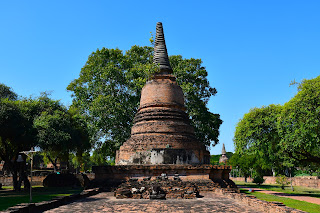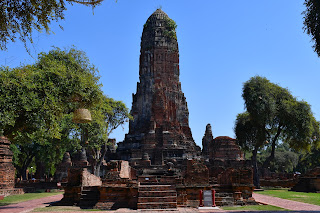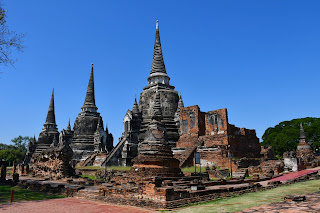A Day Trip to Ayutthaya
When I first began planning my trip to Ayutthaya, I did not think I would be able to see all its attractions in a single day. After all, this legendary city flourished for four centuries as the capital of Siam, one of the most powerful and prosperous kingdoms of Southeast Asia. However, with a bit of planning and a reasonable amount of cab money, a journey from Bangkok and back can take just around ten hours. At eight in the morning, Reese and I were getting breakfast at the Krung Thep Aphiwat train station just as the national anthem boomed from the speakers. When the national anthem played again at six in the evening, Reese and I were in front of the same train station waiting for our cab.
On a slight
tangent, the etiquette that surrounds the playing of the Thai national anthem
is quite interesting. Everyone goes silent, those who are walking stop dead in
their tracks, and those who are sitting stand up – except for monks, who I
assume are exempted by having an even higher allegiance than the state. This
happens wherever there are speakers, such as government buildings, train
stations, and parks, and of course the radio as well. Traffic, I should point
out, does not stop, as that would probably lead to quite a few accidents, and as
not all drivers are constantly tuned into their radio (a similar issue is true
for pedestrians, since it is possible to miss the broadcast when one is wearing
headphones).
Anyway,
back to the narrative of mine and Reese’s journey: Having bought the
twenty-baht third class ticket for the express train to Chiang Mai, Reese and I
boarded our carriage some ten minutes before our scheduled departure at quarter
to nine. I found that the seats in third class are not the most comfortable, and
that sitting across from other passengers requires a tacit negotiation over leg
space. However, the man who sat down opposite to me forestalled all awkwardness
by turning so that his legs faced the aisle. The most salient feature of the
third-class carriages is that they have no air-conditioning, which I can only
assume can be a real nuisance in the summer months but was hardly a problem on
a sunny day in late November.
Once we
arrived in Ayutthaya, we ordered a Bolt cab to Wat Mahathat, one of the major
temples at the heart of the ruined city. Looking at a map, one can discern that
this historic centre is located on an island: Ayutthaya was built at the
confluence of the rivers Chao Phraya, Lop Buri, and Pasak, which are connected
a second time farther north by a manmade canal. The name Ayutthaya is an homage
to Ayodhya, the birthplace of Rama in present-day Uttar Pradesh. It was
officially founded in 1350 by Ramathibodi I, but the city and name date all the
way back to a ninth-century Khmer settlement. For the next four hundred years,
Ayutthaya served as the capital of the eponymous Ayutthaya Kingdom until it was
destroyed by the Burmese in 1767. Following this defeat, the Thais moved their
capital to Thonburi and later Rattanakosin Island in present-day Bangkok.
At Wat
Mahathat we bought our combined ticket to Ayutthaya Historical Park, which
comprises most of the old temples in the city. Wat Mahathat is but one among
many, though it is notable for its haunting Buddha head nestled in the roots of
a bodhi tree. Just north of Wat Mahathat, we then visited Wat Ratchaburana with
its tall and distinctive prang. No less impressive than Wat Mahathat, it had
far fewer tourists, which seemed to be the case for most temples throughout the
city beside Wat Chaiwatthanaram.
Reese said
that last time he visited Ayutthaya, he rented a motorcycle at a restaurant
directly opposite Wat Ratchaburana for 250 Baht. When we showed up, however, we
found that the owner had upped the price by another 100 Baht (either that or
she saw me and decided to apply a European tax). We figured that for this
price, in addition to the fuel costs, we might as well get around by Bolt and
Grab, which was a shrewd calculation. In fact, excluding the drive to and from
the vicinity of the train station, we spent just under 350 Baht on transport.
We
proceeded to explore the rest of the island on foot. Walking across Bueng Phra
Ram Park, we arrived by Wat Phra Ram, where several pairs of tourists
were taking rides on elephants decked out in the royal style. Only one of the pairs was European, indicating
the resonance of animal rights discourse back home. We then continued to Wat
Phra Si Sanphet with its three round chedis and – following a quick lunch – the
reclining Buddha at Wat Lokkayasutha.
This last
temple was where we began our cab hailing across the wider perimeter around the
historic city of Ayutthaya. We first drove north to Wat Phukhao Thong, a
fifty-metre tall chedi whose foundations were laid in 1569 by the invading
Burmese. Following Ayutthaya’s recapture of the area, the chedi was completed
in Thai style. From Wat Phukhao Thong we continued to Wat Chaiwatthanaram, an
impressively large complex with eight large chedis symmetrically surrounding
the central shrine, which itself has another four smaller chedis at its base.
The temple is a favourite among Thai tourists, who like to take pictures there
in rented traditional clothes and holding parasols.
Our next
stop was Wat Phutthaisawan, another ancient temple with a more recent white
prang. Towards the back of the complex stands a half-ruined shrine housing a
reclining Buddha. When we visited it, we saw many people praying as they would
at a temple, even though the roof and parts of the walls were gone. Finally, we
took a cab to the giant chedi at Wat Yai Chai Mongkhon and – walking past Chedi
Wat Sam Pluem at a busy intersection nearby – made our way to the train
station. This last leg happened in a hurry, as we were trying to catch the only
express for the next hour and a half, but once we arrived at the station we
found out it had been delayed by almost half an hour.









































Comments
Post a Comment